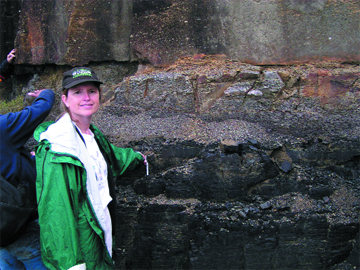 Ever since
scientists found the Chicxulub crater in Mexico and blamed it for the mass extinction
at the end of the Cretaceous, scientists have been trying to locate a crater
on which to pin the even larger mass extinction at the end of the Permian. At
that time, 251 million years ago, more than 80 percent of all marine species
and 70 percent of all land species suddenly disappeared. A group of scientists
now says they have uncovered such a crater, and their results are inciting a
new flurry of controversy.
Ever since
scientists found the Chicxulub crater in Mexico and blamed it for the mass extinction
at the end of the Cretaceous, scientists have been trying to locate a crater
on which to pin the even larger mass extinction at the end of the Permian. At
that time, 251 million years ago, more than 80 percent of all marine species
and 70 percent of all land species suddenly disappeared. A group of scientists
now says they have uncovered such a crater, and their results are inciting a
new flurry of controversy. In the Sydney Basin in Australia, Luann Becker, a geochemist at the University of California, Santa Barbara, points to a coal layer that sits just above the Permian-Triassic boundary layer. Becker led a team that recently announced the discovery of an impact crater off the northwest coast of Australia that they say could be the killer of most of Earth’s life 251 million years ago. Courtesy of Luann Becker.
In the May 13 online Science, a team led by Luann Becker, a geochemist at the University of California at Santa Barbara, describes a possible impact crater off the coast of Australia that they dated to the same time period as the extinctions. It has all the stereotypical signs of an impact crater, says Robert Poreda, a geochemist at the University of Rochester in New York and one of the team members: the right size, age and other characteristics.
The researchers examined a circular uplifted feature under the ocean called the Bedout High, which resembles a common feature of impact craters. Additionally, the team found minerals in Antarctica and across Australia that they say had been shocked by an impact. Seismic imaging profiles, gravity anomaly data and the presence of impact-produced rocks from cores and cuttings from Bedout are consistent with a buried impact crater, Becker says. Furthermore, the presence of extraterrestrial buckyballs — soccer-ball-shaped carbon molecules — puts it all together, she says.
“All of the evidence points to this crater as the proverbial smoking gun” for the P/T extinction event, Poreda says. While many people in the geologic community are surprised and skeptical about the findings, Becker says, “they don’t purport another theory. It’s all about the evidence and we’ve met the burden of proof.”
But Jay Melosh, a geophysicist at the University of Arizona’s Lunar and Planetary Laboratory, remains unconvinced. “The geophysics are not in favor of this even being an impact crater,” he says. “There should be a large circular gravity anomaly, such as at Chicxulub, but there isn’t.” And the seismic profile, he says, clearly resembles that of an ordinary passive subsiding continental margin, matching the tectonic setting at the end of the Permian as the supercontinent Pangea broke up.
Doug Erwin, a paleobiologist at the Smithsonian Institution’s National Museum of Natural History, says he has “some doubts” about how well the research will stand up, particularly because of the wide error bar on the date of the crater. Becker’s team dated the feature to 250.1 million years old, plus or minus 4.5 million years; the Permian extinction event is reliably dated, Erwin says, to 251.6 million years plus or minus 200,000 years. “Plus or minus 4 million years is no longer sufficient in this game,” he says.
Nonetheless, Erwin says that the Bedout study “must be viewed as a credible attempt to advance an impact explanation” for the P/T extinction, and as a useful tool for getting the community talking more about what did cause this extinction event. Although theories abound as to the cause of death — a massive extraterrestrial impact, large-scale volcanism in Siberia, ocean anoxia, extensive climate change or some combination thereof — no one theory has taken center stage.
Steven Stanley, a paleobiologist at Johns Hopkins University, wonders whether a sudden event like an impact could have even caused the P/T extinction event. Research has shown, he says, that there was a massive environmental perturbation that lasted several million years. “How could an abrupt event cause long-term climate change?” he asks. The need to explain this long interval of change, Stanley says, makes it unlikely that the P/T extinction was caused by an impact.
Becker says that she is excited their work is sparking discussion. “This will push us to raise the level of the science,” she says. “It’s kind of a win-win situation. We have so much left to learn.” Indeed, Becker’s team hopes to head back to Australia soon to perform further tests, including more precise dating.

